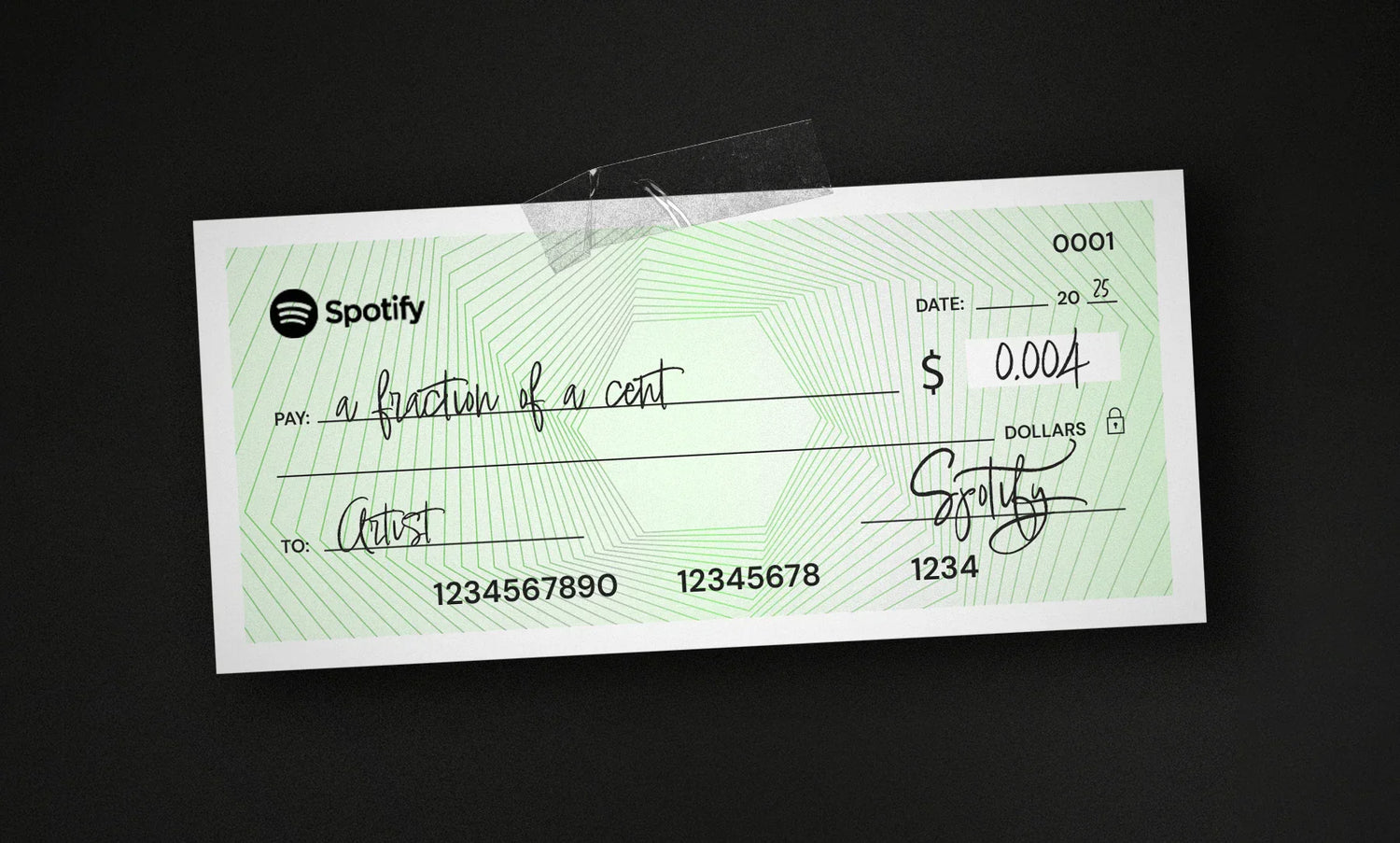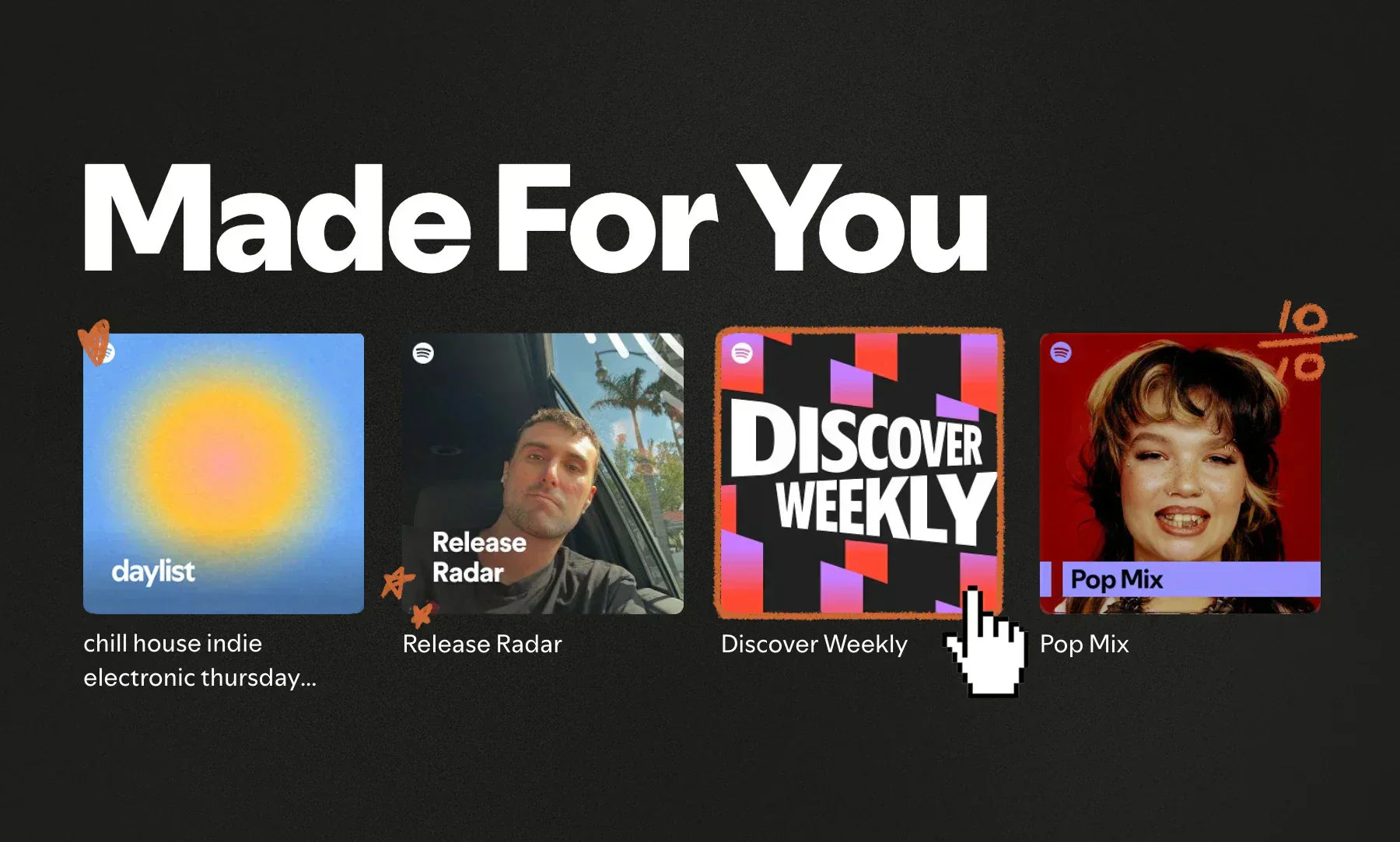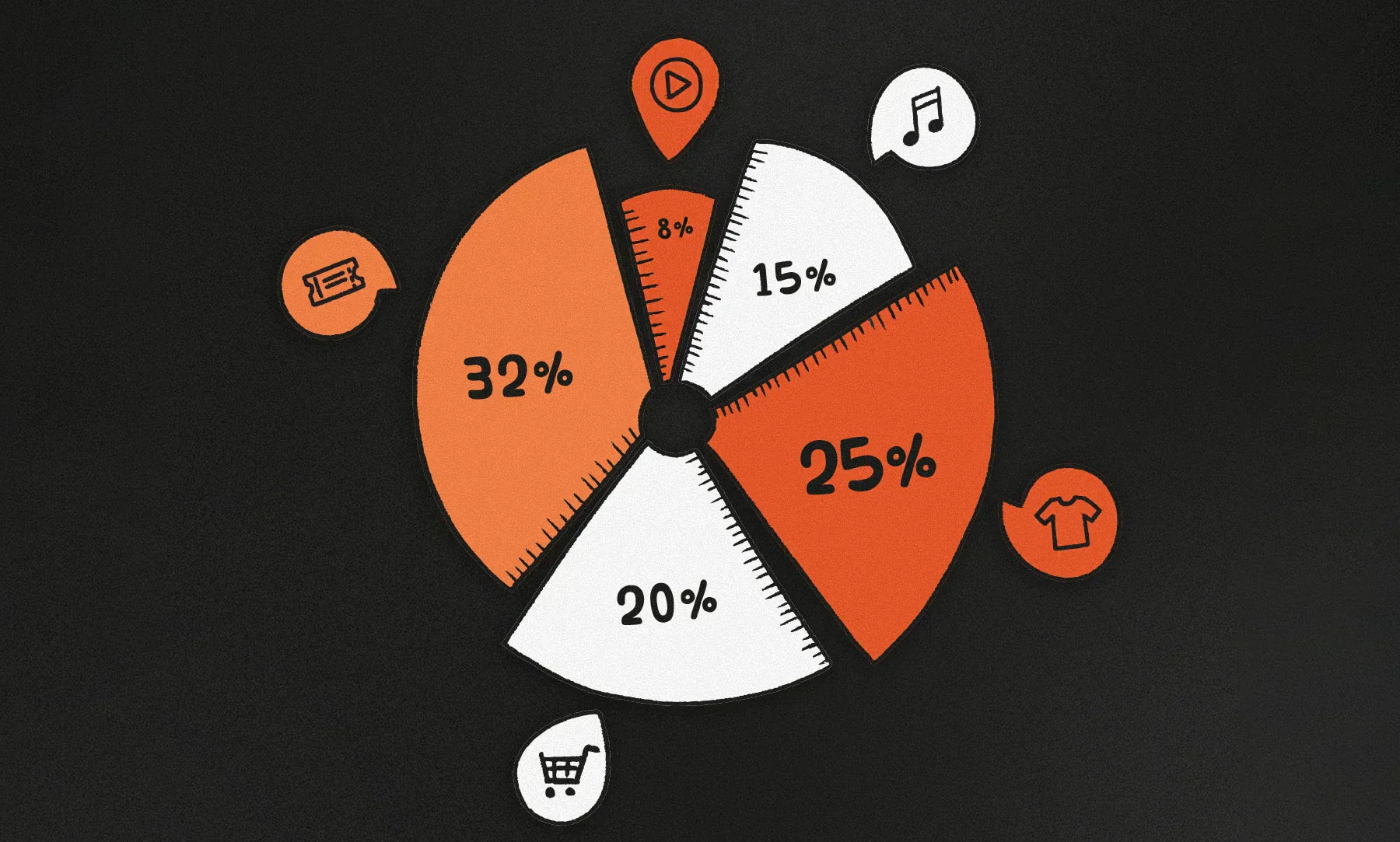You just crossed 100,000 streams on Spotify.
It feels like a win. Then you check your payout and think, "That’s it?"
If you've ever felt that sting, you're not alone. Streaming has changed the music industry in many ways, but when it comes to artist payouts, the system is confusing at best and deliberately unclear at worst.
So, how much do artists actually make on Spotify?
We’re breaking down what you can earn, how to get the most of your money from streaming, and the best strategy to make a sustainable income.
How Does Spotify Pay Artists?
Most people want a straight answer about how much Spotify pays per stream, but it’s not so straight and narrow. Why? Spotify uses a streamshare model instead of paying a fixed amount of money per stream.
That means Spotify collects all its subscription and ad revenue for the month, sets aside a chunk for royalties, and divides that money based on your share of total streams.
For example, let’s say Spotify earns $100 million from U.S. users in a single month and sets aside $70 million for master royalties.
If your song gets 500,000 streams from U.S. listeners that month, and there are 10 billion total streams in the U.S. across the platform, your streamshare is 0.005%.
You’d earn 0.005% of that $70 million, which works out to $3,500 for those 500,000 streams.
That’s why per-stream earnings fluctuate. Your payout depends not just on how many times your song is played, but also who’s listening, where they’re located, what subscription tier they’re using, and how much revenue Spotify brings in that month.
Spotify confirms this structure publicly in its Loud & Clear report.
So your effective per-stream rate depends on factors like:
|
Factor |
Why It Matters |
|
Premium vs Free |
Premium streams generate more revenue than Free-tier streams |
|
Country |
Some markets (like the US and Germany) pay more per listener |
|
Streamshare |
You earn based on your share of total monthly streams |
In 2025, the realistic range for Spotify payouts is about $0.003 to $0.005 USD per stream, and that’s before your distributor or label takes their cut.
If most of your audience is in high-revenue markets and on Premium subscriptions, your average payout will likely be higher. However, Free-tier streams and emerging markets tend to lower your average. This makes country targeting and Premium-focused growth strategies more important than ever.
Spotify’s 1,000-Stream Rule
In April 2024, Spotify introduced a new eligibility rule: Tracks must receive at least 1,000 streams in the past 12 months to earn any master royalties.
This policy is designed to reduce fraud and filter out low-engagement tracks. It is fully documented on Spotify’s official help page.
This rule applies to each track, not your entire catalogue. So if one of your songs is sitting at 950 streams in a year, it will earn nothing on the master side until it crosses the 1,000-stream line. Once it does, it becomes eligible to earn royalties again.
Spotify also clarified that this is a rolling 12-month window, meaning tracks can become ineligible again if they fall below the threshold in future months.
Why This Rule Matters for Indies
The frustration is real. One artist summed it up like this:
“If I have 10 tracks that are just under 1,000 streams, say 950 each, that’s close to 10,000 streams total, and I get ZILCH. It’s like running a small burger stand and watching all your customers pay McDonald’s instead.”
Spotify’s intent with this rule is to limit fraud and junk uploads. But for indie artists who are building catalogues slowly, or with niche audiences, it can feel like being penalized for growing organically.
This policy makes early momentum more important than ever. Launch promotional strategies that help you cross the 1,000-stream line quickly.
If you notice some of your older tracks are stuck in stream jail, consider running a playlisting campaign to tip them over the edge. It could unlock passive revenue for the next year.
How Much Do You Actually Get Paid at Different Stream Levels?
For the sake of simplicity, let’s use Spotify’s often cited average rate of $0.004 per stream, so we can see how this practically plays out for artists.
Again, Spotify does not confirm exact per-stream rates but acknowledges that you may see a variation because of multiple factors.
How Much Spotify Pays Artists: Before Distributor Or Label Cuts
|
Streams |
Gross Earnings (at $0.004/stream) |
|
100,000 |
$400 |
|
1,000,000 |
$4,000 |
|
10,000,000 |
$40,000 |
The following table shows how much your business model can impact what you actually take home. You should always run these calculations before choosing a distributor.
How Much Spotify Pays Artists: After Distributor Or Label Cuts
|
Deal Type |
Artist Keeps |
Net on 1M Streams ($4,000 gross) |
|
Flat-fee distributor |
100% |
$4,000 |
|
10% distribution cut |
90% |
$3,600 |
|
Label services (80/20 split) |
80% |
$3,200 |
|
Traditional label (25% to artist) |
25% |
$1,000 |
These numbers might look neat on a spreadsheet, but the real-world experience for most artists is far from profitable.
One indie artist pointed out that it takes over 187,000 streams just to equal a single week of minimum-wage work in the UK. Another calculated that 340 streams barely buys them a guitar pick, the cheapest part of making music.
These aren’t exaggerations. These are the calculations artists now have to make to stay afloat.
When even small tools like strings, cables, or DAW subscriptions require thousands of streams to cover, the economics get bleak fast.
What About Discovery Mode?
Discovery Mode is Spotify’s internal boost tool. It lets you push selected tracks into algorithm-driven surfaces like Autoplay and Radio.
There’s no upfront cost, but Spotify takes a 30% cut of your recording royalties from any stream that comes through Discovery Mode placements. That directly impacts your payouts, which is why understanding how and when to use it matters.
How Discovery Mode Can Help You Cross 1,000 Streams
If your song is stuck just below Spotify’s 1,000-stream threshold, Discovery Mode might help tip it over.
That threshold matters: you earn nothing on the master side until a track hits 1,000 streams in the past 12 months. Even a short Discovery Mode push can help you cross that line and start collecting on a track that would otherwise sit unpaid.
The 30% cut only applies to Discovery Mode streams, so the moment it starts performing elsewhere, you get the full rate again.
Who’s Eligible For Discovery Mode?
Spotify doesn’t open this tool to everyone. To be eligible, you need at least 25,000 monthly listeners and must work with a distributor that’s opted into Discovery Mode.
If you qualify, it’s worth testing, but treat it like a scalpel, not a sledgehammer. Start small, pick strong-performing tracks, and watch whether it drives saves, repeat listens, and organic growth outside Discovery Mode itself. If it’s not leading to long-term growth, consider opting out.
Functional Audio Rules and Track Length Minimums
Also in 2024, Spotify updated its policy on “functional” content, such as white noise, nature recordings, or anything that lacks a melody.
According to Spotify for Artists, the following changes apply:
- Minimum track length of 2 minutes for functional recordings to qualify for monetization (there’s no minimum track length for music, but a person has to listen to at least 30 seconds to earn royalties).
- Reduced payout rate for noise-type content to prevent catalogue flooding.
These updates are part of Spotify’s wider initiative to “improve payout fairness and reduce manipulation.”
If you release ambient or sleep-related music, you’ll want to check that your tracks meet the length requirement. Otherwise, you may not be eligible for royalties.
What About Publishing Royalties?
When your song streams on Spotify, there are two main types of royalties:
- Master royalties (for the recording, paid to your distributor or label)
- Publishing royalties (for the composition, paid to songwriters via collection societies)
Spotify pays publishing royalties through multiple partners. You must be registered with the right organizations to collect.
Here’s a quick breakdown:
|
Royalty Type |
Collecting Organization |
|
US mechanical royalties |
|
|
Performance royalties (US) |
|
|
Performance royalties (Canada) |
|
|
Neighbouring rights (Canada) |
If you want the full guide to maximize your royalties, check out our blog post here.
YouTube also generates publishing revenue via Content ID, which can be claimed through a distributor or a publishing administrator.
If your song is not registered with The MLC or your PRO, you may be missing money you’ve already earned. You can use The MLC’s searchable database to find unmatched works and claim them.
How Much Has Spotify Paid the Industry?
In January 2025, Spotify announced that it had paid over $10 billion USD to the music industry in 2024, the highest single-year payout in its history.
This number includes payments to labels, publishers, distributors, and collection agencies worldwide.
The company also stated that more than 1,200 artists earned over $1 million in 2023, and more than 11,000 artists earned over $100,000. While those artists are not all independent, the trend shows that the platform can deliver significant income for those positioned well.
How To Get Paid By Spotify: A Royalty Roadmap
Here’s a no-fluff roadmap based on verified Spotify and MLC guidance:
- Register with The MLC and your local PRO
- Use a flat-fee distributor (if under 1M streams per year)
- Push each track above 1,000 streams to stay eligible
- Focus marketing on Premium-heavy countries
- Clean up metadata and ISRCs before release
- Opt into Discovery Mode cautiously and track results
- Claim YouTube Content ID through a partner if needed
You’ll also want to keep your Spotify for Artists profile updated, use pre-save campaigns, and watch your save/skip rates during the first 30 days of each release.
These signals help you land in Spotify algorithmic playlists like Release Radar and Discover Weekly.
Build a System, Not Just a Song
Streaming was pitched as the great equalizer. But in practice, it’s become a race where the winners are legacy artists with back catalogues and massive label infrastructure.
As one commenter on our Instagram page put it, “Music is now blades of grass. Pick it, throw it away, there’s more for free around the corner.”
That commodification doesn’t reflect the real cost of making music: gear, engineering, studio time, marketing, and the creative labour that fuels it all.
Another nailed the bigger picture: “There is loads of money in music. It just doesn’t go to musicians.”
That’s the hard truth. But here’s the opportunity: you can still build a system that works for you. One that treats streaming as just one piece of a bigger plan, not your only income source, and definitely not your only shot. Bring in other income streams like merch, live shows, and sync licensing.
Spotify’s pay-per-stream rate might not be easy to pin down, but your strategy can be.
Control your rights. Register every royalty stream. Watch your splits. Run playlist promotion campaigns to push past 1,000 streams. Play the long game.
Because if the platform won’t change the rules, the smartest thing you can do is learn how to work within it and build a system that works in your favour.


